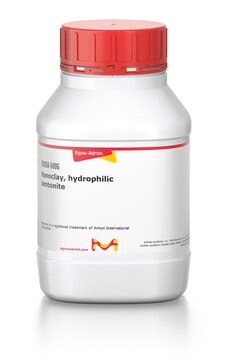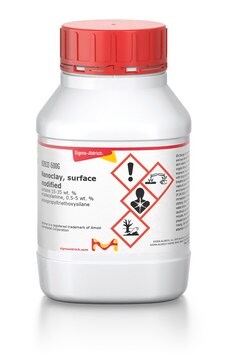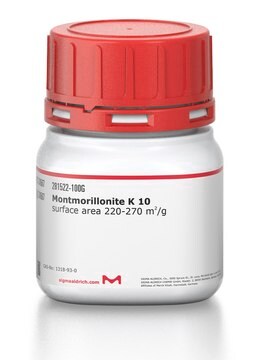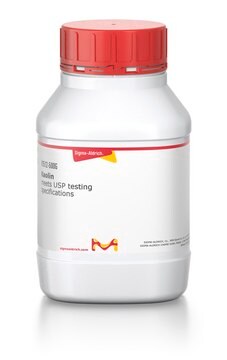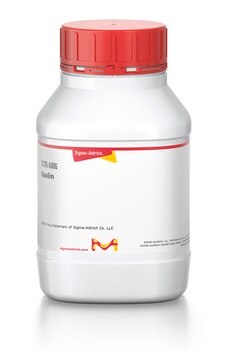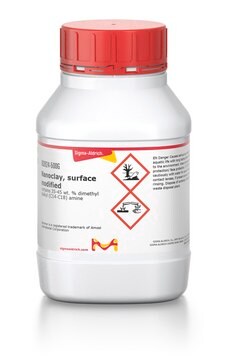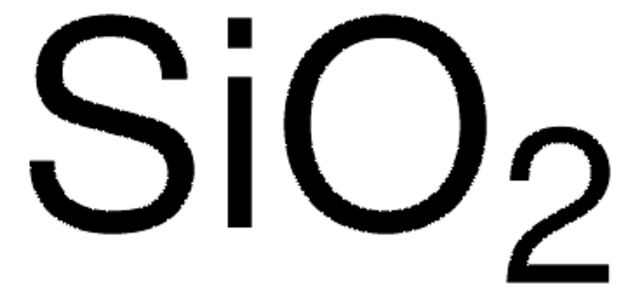285234
Bentonite
Synonyme(s) :
Montmorillonite
Se connecterpour consulter vos tarifs contractuels et ceux de votre entreprise/organisme
About This Item
Numéro CAS:
Numéro CE :
Numéro MDL:
Code UNSPSC :
12352300
ID de substance PubChem :
Nomenclature NACRES :
SB.52
Produits recommandés
Forme
powder
Température de stockage
room temp
Chaîne SMILES
O.O=[Si]=O.O=[Si]=O.O=[Si]=O.O=[Si]=O.O=[Al]O[Al]=O
InChI
1S/2Al.4O2Si.H2O.3O/c;;4*1-3-2;;;;/h;;;;;;1H2;;;
Clé InChI
KARVSHNNUWMXFO-UHFFFAOYSA-N
Vous recherchez des produits similaires ? Visite Guide de comparaison des produits
Catégories apparentées
Description générale
Bentonite is comprised primarily of the smectite group (montmorillonite) of clay minerals. It is widely used in various industrial applications such as clarification of edible and mineral oils, paints, cosmetics, and pharmaceuticals. It is also used as an adsorbent for the elimination of pollutants from wastewater.
The swelling property of bentonite is used to produce viscous water suspensions for bonding, plasticizing, and suspending applications. The presence of a large surface area of bentonite is due to the colloidal dispersion of the particles is the main reason for its application as an insecticide carrier, an emulsifier, and an emulsion stabilizer.
The swelling property of bentonite is used to produce viscous water suspensions for bonding, plasticizing, and suspending applications. The presence of a large surface area of bentonite is due to the colloidal dispersion of the particles is the main reason for its application as an insecticide carrier, an emulsifier, and an emulsion stabilizer.
Application
- Optimization of Cd (II) removal from aqueous solution by natural hydroxyapatite/bentonite composite using response surface methodology.: This study explores the use of a hydroxyapatite/bentonite composite for the efficient removal of cadmium ions from aqueous solutions, highlighting its potential application in environmental remediation (Desalegn et al., 2023).
- Acid-activated Sodium Bentonite and Kaolin Clay: Comparative Study by Physicochemical Properties.: This research compares the physicochemical properties of acid-activated sodium bentonite and kaolin clay, focusing on their potential applications in various industrial processes and environmental treatments (Kumar & Lingfa, 2020).
- Photochemical synthesis of silver nanoparticles on chitosans/montmorillonite nanocomposite films and antibacterial activity.: The research focuses on the synthesis of silver nanoparticles on chitosan/montmorillonite nanocomposite films and their enhanced antibacterial activity, suggesting potential applications in medical and environmental fields (Gabriel et al., 2017).
Code de la classe de stockage
11 - Combustible Solids
Classe de danger pour l'eau (WGK)
WGK 3
Point d'éclair (°F)
Not applicable
Point d'éclair (°C)
Not applicable
Faites votre choix parmi les versions les plus récentes :
Déjà en possession de ce produit ?
Retrouvez la documentation relative aux produits que vous avez récemment achetés dans la Bibliothèque de documents.
Les clients ont également consulté
Applications of Bentonite in the Industrial Wastewater Treatment [J]
Xiaotong G and Zhiming Z
Chemical Production and Technology, 3 (2006)
Adsorption of methylene blue from aqueous solution by crosslinked chitosan/bentonite composite.
Bulut Y and Karaer H.
Journal of Dispersion Science and Technology, 36(1), 61-67 (2015)
Yuwen Huang et al.
Mutation research, 751(1), 40-44 (2012-11-08)
It has been found that bentonite particles (BPs) could induce the cyto-genotoxicity and oxidative stress in vitro, but these effects on population exposed to BPs remain unclear. The aim of the present study was to investigate whether the genetic damage
Shilong He et al.
Environmental technology, 33(19-21), 2337-2344 (2013-02-12)
Bromate is an emerging hazardous substance in drinking water. In this study, the removal ofbromate by Fe-pillared bentonite was investigated using various experimental parameters: contact time, initial concentration (Co), temperature, initial pH and competing anions. The adsorption ofbromate followed the
Laurent J Michot et al.
Langmuir : the ACS journal of surfaces and colloids, 29(10), 3500-3510 (2013-02-21)
The coagulation of sodium montmorillonite by inorganic salts (NaNO3, Ca(NO3)2 and La(NO3)3) was studied by combining classical turbidity measurements with wide-angle-X-ray scattering (WAXS), small-angle-X-ray scattering (SAXS), and transmission X-ray microscopy (TXM). Using size-selected samples, such a combination, associated with an
Notre équipe de scientifiques dispose d'une expérience dans tous les secteurs de la recherche, notamment en sciences de la vie, science des matériaux, synthèse chimique, chromatographie, analyse et dans de nombreux autres domaines..
Contacter notre Service technique